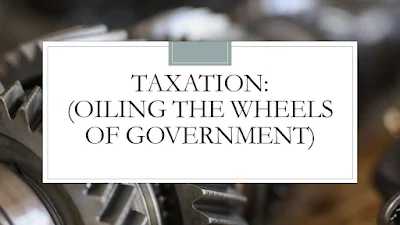Funds are required by the government to carry out their functions ie developmental as well as day to day functions. Taxation provides funds for carrying out such functions.
TAXATION:
- Taxation is a legal compulsory payment by the citizens to the government.
- There is no quid pro quo relationship between a taxpayer and the collecting authority.
- Taxpayer can neither claim any specific benefit against paid taxes nor it can ask its taxes back if desired services are not provided by the government.
CANONS OF TAXATION:
The most fundamental classification of taxes is based on who collects the taxes from the tax payer.
As Per Adam smith, Taxation should follow the following canon of taxation :
- Canon of ability :taxes should be paid as per the ability .
- Canon of certainty :rate of taxes should be clear with out any ambiguity .
- Canon of convenience :The tax collection method should be convenient so that people can pay taxes easily.
- Canon of economy: Government should impose only those taxes whose collection costs are very less and cheap as there are collection costs undertaken by the government.
Anecdotes related to Taxation:
In Mahabharat:
Krishna started his campaign against kansa by not paying Income tax imposed by Kansa and krishna argued that kansa has abdicated his responsibility as a king so people should not pay the taxes.
In Ramayana:
- Shri Rama pointed out that it was necessary to collect tax from the subjects.
- But the tax should be taken by a king in the same way as the sun absorbed water from the earth.
- In reservoirs and rivers, where there was more water, it took more; from the land where there was less water, it took little.
- In the same way it was also the duty of the ruler to make it clear that the tax collected from the rich people of the state should be distributed equally for the works in the larger interest of the people.
TAX IMPACT:
- The term Tax impact is used to express the immediate result of imposition of the tax.
- The impact of a tax is on the person on whom it is imposed first.
- Thus, the person who is liable to pay the tax to the government bears its impact.
TAX INCIDENCE:
Tax incidence is liability of the tax payment on the man’ who ultimately bears the
burden of the tax.
TAX IMPACT vs TAX INCDENCE:
- Tax Impact refers to the initial burden of the tax, while Tax incidence refers to the ultimate burden of the tax.
- Tax Impact is at the point of imposition while incidence occurs at the point of settlement.
- Tax impact of a tax falls upon the person from whom the tax is collected and the incidence rests on the person who pays it eventually.
- Tax Impact may be shifted but Tax Incidence cannot be shifted.
TAX SHIFTING:
- Tax Shifting is passing of the tax from the one who first pays it to the one who finally bears it.
- It is through this process of Tax Shifting that the impact of a tax is transformed to Tax incidence.
- Tax Incidence is the end of the shifting process.
- Direct tax are example where Tax impact and Tax incidence are borne by the same person
while
- In case of indirect taxes, Tax impact and Tax incidence are borne by different person through the process of Tax shifting.
TYPES OF TAXATION:
Taxation can be in the form of: Direct Tax and Indirect tax.
DIRECT TAX:
- Direct Tax is a tax that is paid directly by an individual or organization to the imposing entity .
- There is no Tax Shifting as tax impact and tax incidence is on the same person.
- A taxpayer pays direct tax to the government for different purposes.
- Tax payment cannot be shifted to another individual or entity.
- Direct taxes include income tax, Property tax, capital gains tax, Direct Dividend Tax, corporate tax etc.
- Income tax is the most popular direct tax.
IMPLICATIONS OF HIGHER DIRECT TAXATION:
- Direct tax collection accounted for 55% in FY 2022-23 which was 4 year high .
- A higher direct tax to indirect tax is considered as progressive in the sense that indirect taxation hurts the poor more intensely.
INDIRECT TAX:
- Those taxes which are not directly levied on the Income of an Individual.
- This tax is indirectly levied on the Expenses incurred by the Individual.
- This tax is basically levied on the seller of goods but finally it is being paid by the end consumer.
- Examples: GST, custom duty










